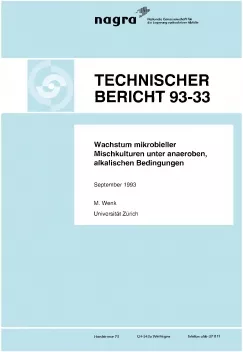
Technischer Bericht NTB 93-33
Wachstum mikrobieller Mischkulturen unter anaeroben, alkalischen Bedingungen
Cement and concrete are the most important engineered barrier materials in a repository for low- and intermediate-level waste and thus represent the most significant component of the total disposal inventory. Based on the chemical composition of the concrete used in the repository and the groundwater fluxes in the modelled host rock, it is to be expected that the pH in the near vicinity of the repository could exceed a value of 10.5 for more than a million years. The groundwater in the repository environment also has a limited carbon concentration. Since microorganisms will be present in a repository and can even find suitable living conditions within the waste itself, investigations were carried out in order to establish the extent to which microbial activity is possible under the extreme conditions of the repository near-field.
For the investigations, alkalophilic mixed cultures were enriched from samples form alkaline habitats and from Valanginian Marl. Anaerobic bacteria with fermentative, sulphate-reducing and methanogenic metabolisms were selected. The growth and activity of the mixed cultures were studied under alkaline conditions and the dependence on pH and carbon concentration determined.
All the mixed cultures investigated are alkalophilic. The optimum growth range for the cultures is between pH 9.0 and pH 10.0. The activity limit for the fermentative mixed culture is at pH 12, for the sulphate-reducers at pH 11 and for the methanogens at pH 10.5. Given the limited supply of carbon, the mixed cultures can only grow under slightly alkaline conditions. Only the fermentative cultures are capable of surviving with limited carbon supply at pH 13.
Organisms of the two strictly anaerobic metabolic types (sulphate-reducers and methanogens) will initially have very low activity levels in the disposal zone at pH values over 10.5. Fermentative bacteria, on the other hand, are capable from the start of surviving the extreme conditions in the vicinity of the repository. Even though their growth rate my be slow, they are capable of creating niches with less extreme conditions in which other less alkali-resistant organisms can then grow. Microbial activity, and its consequences for repository safety, cannot therefore be ruled out even under extreme conditions.
